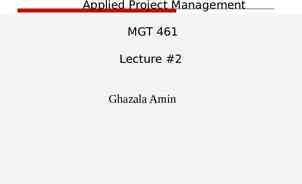Section 3.2: Operating Systems Security 1
11 Slides2.51 MB
Section 3.2: Operating Systems Security 1
The Boot Sequence When a computer is turned on, it first executes code stored in a firmware component known as the BIOS (basic input/output system). On modern systems, the BIOS loads into memory the second-stage boot loader, which handles loading the rest of the operating system into memory and then passes control of execution to the operating system. 2
BIOS Passwords A malicious user could potentially seize execution of a computer at several points in the boot process. Live CD attack: attackers use a bootable external media to boot up a computer in order to obtain hard drive data. – Original OS cannot protect data anymore. 3
BIOS Passwords BIOS password: that does not allow a secondstage boot loader to be executed without proper authentication. – Set up hard drive as the first boot device – Prevent BIOS editing without the password Attackers can remove HD, install it in another computer to boot up – A better defense is to use hard disk encryption 4
Hibernation Modern machines have the ability to go into a powered-off state known as hibernation. – OS stores the contents of machine’s memory into a hibernation file (such as hiberfil.sys) on disk so the computer can be quickly restored later. But without additional security precautions, hibernation exposes a machine to potentially invasive forensic investigation. 1. User closes a laptop computer, putting it into hibernation. 2. Attacker copies the hiberfil.sys file to discover any unencrypted passwords that were stored in memory when the computer was put into hibernation. 5
Event Logging Keeping track of what processes are running, what other machines have interacted with the system via the Internet, and if the operating system has experienced any unexpected or suspicious behavior can often leave important clues not only for troubleshooting ordinary problems, but also for determining the cause of a security breach. 6
Process Explorer Download from: http://technet.microsoft.com/en-us/sysinternals/bb896653 Provides more detailed information of processes than Windows Task Manager 7
Password Security Instead of storing passwords as plaintext, most OSes store the hash values in password files. Dictionary attack: with obtained password file, each word in a dictionary is hashed and the resulting value is compared with the hashed passwords stored in the password file. A dictionary of 500,000 “words” is often enough to discover most passwords. 8
Password Salt One way to make the dictionary attack more difficult to launch is to use salt. Associate a random number with each user id. OS compares the hash of (password salt) with the stored hash of the (password salt). Unix system password file: – /etc/passwd – Possible conjunction with /etc/shadow 9
How Password Salt Works Without salt: 1. User types userid, X, and password, P. 2. System looks up H, the stored hash of X’s password. Password file: X: H 3. System tests whether h(P) H. With salt: 1. User types userid, X, and password, P. 2. System looks up S and H, where S is the random salt for userid X and H is stored hash of S X’s password. 3. System tests whether h(S P) H. Password file: X: Ek(S), H 10
How Salt Increases Search Space Size Assuming that an attacker cannot find the salt associated with a userid (e.g., salt is encrypted) then the search space for a dictionary attack on a salted password is of size 2B*D, where B is the number of bits of the random salt and D is the size of the list of words for the dictionary attack. For example, if a system uses a 32-bit salt for each userid and its users pick passwords in a 500,000 word dictionary, then the search space for attacking salted passwords would be 232 * 500,000 2,147,483,648,000,000 Also, even if an attacker can find a salt password for a userid, he only learns one password. – Since different users’ salts are different. 11
















